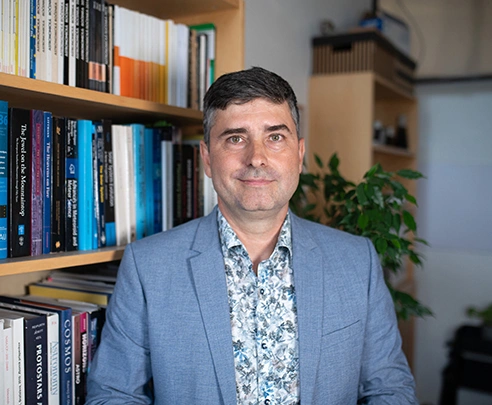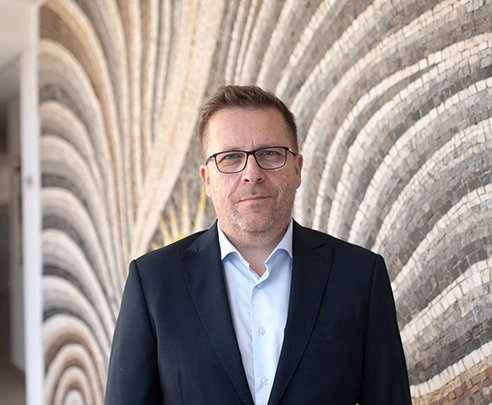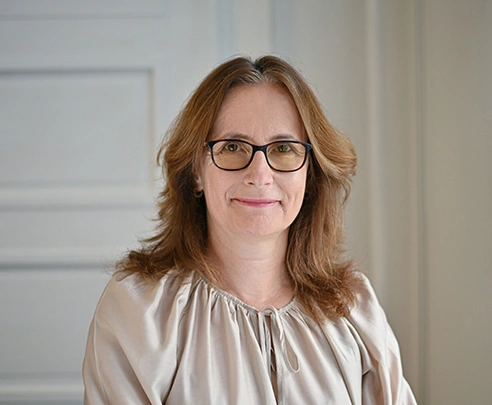Adriana Zeleňáková’s scientific research takes place in the world of nanoparticles, which are roughly a thousand times smaller than the thickness of a human hair. As an experimental physicist, she began her scientific and teaching career by “diving” into waters that had previously only been explored theoretically. Today, Assoc. Prof. RNDr. Adriana Zeleňáková, DrSc. is the head of the Department of Condensed Matter Physics at the Institute of Physical Sciences, Faculty of Science, Pavol Jozef Šafárik University in Košice, and she is nurturing a new generation of scientists in the field of nanotechnologies. Her pioneering research focuses on the magnetism of nanoparticles, with an emphasis on relaxation processes, and she concentrates on applications of magnetic nanoparticle systems in biomedicine—such as therapeutic and diagnostic platforms—as well as in energy technologies.
Her initial motivation to study nanoparticles came from her scientific family, specifically her husband, who is also a scientist—a chemist. “Our first chemical syntheses of nanoparticles were a great adventure because we had no idea what results we would achieve,” recalls Adriana Zeleňáková. The magnetic nanoparticles she studies are physical objects on the nanometre scale, composed mainly of atoms of ferromagnetic elements such as iron, cobalt, and nickel, but they exhibit behaviour that is unlike either atoms or bulk materials. “For me, it’s very unique—and I’m grateful for it—that I can witness the birth of entirely new physical behaviour that will be in textbooks in a few years,” says the respected researcher.
“The quality of human life, and of civilization as a whole, is closely linked to physics and knowledge in the natural sciences. That’s why I see scientific research as a form of service,” notes Assoc. Prof. Zeleňáková, whose research has three main biomedical application areas. The first is contrast agents for magnetic resonance imaging, where magnetic nanoparticles have been commercially used since 2010. The second is their use as drug carriers. “Magnetic nanoparticles are like a core, with a porous shell on the surface and the drug stored inside. We can deliver it to an organ using a magnetic field, reduce the therapeutic dose, and minimize negative effects on healthy cells,” she explains. The third area is magnetic hyperthermia—a treatment for cancer that is already being piloted. “Magnetic nanoparticles are applied directly into the tumour in solution form, and the patient is placed in an external magnetic field. The nanoparticles vibrate under the influence of the field and emit energy in the form of heat, which is sufficient to trigger apoptosis of the tumour tissue.”
Energy is another application area of the nanoparticle research team at the Košice university, specifically the magnetocaloric effect for cryogenic applications at very low temperatures. “For example, quantum computers require cooling with liquid helium. The magnetocaloric effect offers an alternative—an elegant, inexpensive, and efficient cooling method for future technologies,” explains the experimental physicist.
Assoc. Prof. Zeleňáková also sees future applications of magnetic nanoparticles in the diagnosis of viral diseases. After the outbreak of the COVID-19 pandemic, her team contributed to the development of PCR tests that significantly accelerated diagnostics thanks to the use of magnetic nanoparticles. Her greatest scientific achievement is the discovery of superspin glass in nanoparticles—a new magnetic state, the understanding of which may aid applications in biomedicine or quantum technologies. Publishing scientific studies in the most prestigious journals and receiving hundreds of citations enabled the global scientific community to accept this discovery, with which she closely collaborates.
At the Faculty of Science of Pavol Jozef Šafárik University in Košice, Adriana Zeleňáková founded a unique school of magnetic nanoparticles, and her greatest teaching success is the students and seven PhD candidates she has mentored so far. “I love teaching, and I enjoy it more and more. The lectures where we experiment get the best response. Students can practically verify what they’ve learned theoretically. I also give them bonus tasks to motivate them to look for connections, which I consider the most important aspect of physics.”
Assoc. Prof. Zeleňáková is inspired by two giants of science—Richard Feynman and Nikola Tesla. Feynman, Nobel Prize winner in physics, didn’t directly work on nanotechnologies, but his legendary 1959 lecture “There’s Plenty of Room at the Bottom” suggested that there is vast space for discovery at the atomic and molecular level—essentially laying the conceptual foundation for nanotechnology. Nikola Tesla inspires her with his discoveries in electromagnetism. Both represent the courage to think unconventionally and explore uncharted paths—a philosophy that runs through her entire research.
One of the greatest inspirations in science, according to Adriana Zeleňáková, is the environment. “For our nanoparticle team, physical research is not just work, fun, mission, and hobby—it’s truly everything. We pass this knowledge on to future generations.” Science also shapes her personally. “The most important thing is to be honest and truthful. As Feynman said: the easiest person to fool is yourself,” says the scientist, who in her free time enjoys singing, swimming, hiking, spending time with family, gardening, and endless scientific discussions with her husband.
Adriana Zeleňáková’s scientific dreams have no limits. “I believe that a soldier who doesn’t aspire to be a general isn’t a good soldier. When our nanoparticle team encounters a problem we can’t solve, we say its solution is worthy of a Nobel Prize. You have to dream big and strive for the highest goals,” concludes the passionate scientist.



